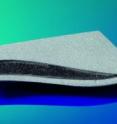Plastic monitors itself
When the storm winds blow, wind turbines have to show what they can stand up to. The wind blows hard against mills with the force of tons as the tips of the blades plow through the air at more than 200 kilometers per hour. But natural forces not only tear at wind turbines; machine components made of plastic or airplane wings must with stand substantial loads as well. These days, we normally use sensors to measure whether these components are strained beyond capacity, and it requires a lot of effort to install them into the component parts or glue them onto their surface. Because these monitoring sensors usually only register tensile or pressure loads in a small range, we link several individual sensors to create a single network if we want to record greater areas on the component. Researchers at Fraunhofer Institute for Manufacturing Technology and Applied Material Research (IFAM) in Bremen, Germany, are now making it measurably easier to inspect these large-scale components because they have come up with a new composite material especially for components made of plastic. It has sensory properties that can be directly worked or installed into a synthetic component when it is manufactured. This material also meets design requirements.
This new composite material is a blend of plastic and metal better known as polymer-metal composite material. There is a wide range of plastics that are suited as a matrix material for manufacturing this composite, which means that it can easily be tailor-made for a whole series of purposes. But it also has other advantages. First of all, due to its synthetic character, this material can be easily processed. Beyond this, it is lightweight and conducts current and heat very well due to the high proportion of metal in it. What is especially fascinating about this material is the fact that it can be processed with conventional machines used in plastics manufacturing – among other things, in extruders or in injection-molding machines in which the heated liquid plastic is injected into a form where it hardens immediately. Finally, this material can be laminated as a type of mat on large surfaces. In the future, researchers want to use nozzles to apply this conducting plastic as a viscous liquid to geometrically complex surfaces.
This polymer-metal composite material has its high proportion of metal and a special mixing technique to thank for its excellent sensory properties. As Arne Haberkorn, the project manager for composite developments at the Fraunhofer Institute for Manufacturing Technology and Applied Material Research, points out, "we reach a metallic filling proportion of as much as 90 percent in weight in this composite when needed," with the composite's electrical resistance changing if there are loads during operation. The signals can be drawn off with cables on the component part and passed them onto a measuring instrument for analysis.
It was a special challenge for Haberkorn and his colleagues to come up with a technique for evenly processing different metallic substances in liquid plastic. This new technique functions with a whole range of synthetic materials, for instance with polypropylene just as well as with polyamide. Haberkorn is happy to say "this means we can combine our polymer-metal composite material with various synthetics and process them into a wide range of component parts. That includes not only solid and heat-resistant, but also soft-flexible workpieces." Researchers have used various prototypes to demonstrate that the method functions and are now searching for potential industrial users.
Source: Fraunhofer-Gesellschaft
Other sources
- Plastic monitors itselffrom Science DailyTue, 19 Oct 2010, 16:32:36 UTC
- Plastics and nanoparticles -- the perfect combinationfrom Science DailyTue, 19 Oct 2010, 3:32:22 UTC
- Plastic monitors itselffrom PhysorgMon, 18 Oct 2010, 20:31:13 UTC
